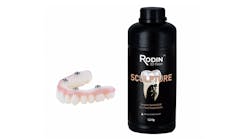I recently came across some photos of my dad’s dental office and his dentistry from the 1970s. Everything in the office is what you would expect from an office from that time: Red carpet. Cuspidors. Ashtrays. His office was perhaps the most 1970s thing I have ever seen in my life.
The dentistry he was doing was no surprise either. Cast gold. In fact, one of the photos showed the laboratory of the office, which contained a casting well. That means that my dad and his partners would wax and cast some of their own restorations in the office. As someone who has had the prime of his career in the monolithic era of dentistry, this will always be astounding to me. However, we all know dentists who do milled dentistry in their office the same way.
More Pearls:
Re-Gen Bioactive EndoSealer by Vista Apex
Strata-G Matrix System by Garrison
The problem is the change in workflow that comes with that. 3D printing changes some of that equation and makes it more reasonable for dentists to do some of their own lab work again. We’ve just needed the printable resins to evolve more to fulfill our needs. The newest generation of resins, including Rodin Sculpture 3D, is a huge step in that direction.
Rodin Sculpture 3D is a ceramic nano hybrid resin that can be used to print restorations such as definitive crowns, onlays, inlays, veneers, and hybrids. That’s right—definitive. Not provisional. This material has esthetic enhancements to make them one of the most beautiful 3D printed restorations available. In addition to the enhanced esthetics of the material itself, improvements can be made with some of the available light curable stain and glaze systems built for Rodin Sculpture 3D.
This material is accepted by the ADA and meets the requirements for the updated 2023 CDT coding for an all-ceramic crown thanks to Rodin Sculpture 3D’s ceramic nano hybrid chemistry. In addition to the esthetic characteristics, it has great mechanical properties that make it strong and wear resistant. There are multiple 3D printers that already have verified compatibility with Rodin Sculpture 3D. Ackuretta, Asiaga, and Phrozen printers are ready to roll; Carbon printers are currently being verified and should be ready to roll soon.
A restoration printed with Rodin Sculpture 3D should be cleaned with 99% isopropyl alcohol until any uncured resin is removed. It should then be postcured to manufacturer specification, and then finally glazed and polished. Chairside adjustment can be done with carbide burs and repolished as you would any composite restoration. Any resin cement should work well with Rodin Sculpture 3D. You do have some shade options, as this material comes in 16 shades.
3D printing of restorations in-house is the next evolution in restorative dentistry. This technology can be added to your practice for less than milling and gives us the flexibility to produce many different types of restorations, from single units to full arches.
Editor's note: This article appeared in the August 2023 print edition of Dental Economics magazine. Dentists in North America are eligible for a complimentary print subscription. Sign up here.







